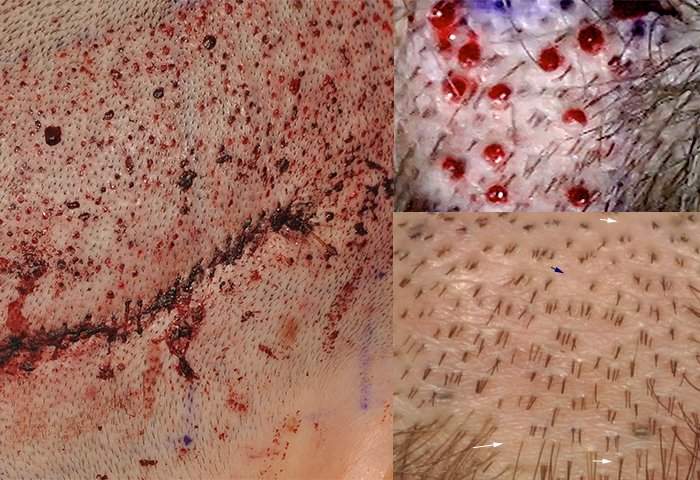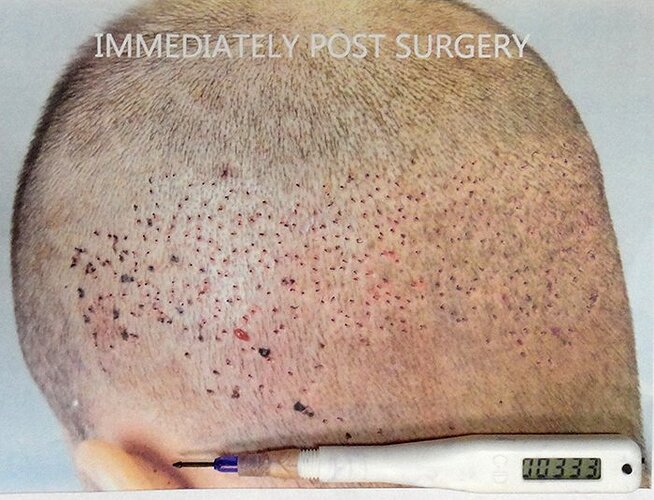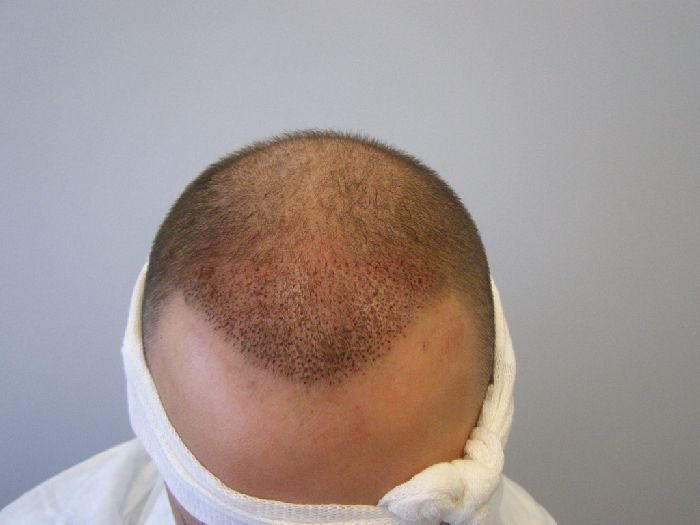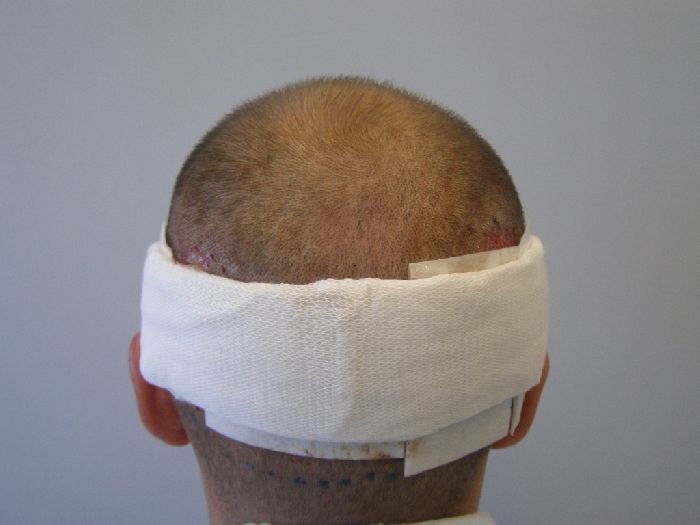The comment relates to the number of extraction sites that are visible in post surgery photos. At best, he can see a little over 300 extraction sites. That’s a long way from 1500 extraction sites.
I don’t think it’s possible to suggest that FUE done by any means leaves an undetectable donor area in all instances. when one claims to extract 1500 grafts, but they extract far fewer grafts (in this instance about 333 in 75% of the donor area), they are asking for trouble. People are not fools. Those of us who have been doing this a long time certainly are not fools. When we can look at a donor area and we see a widely scattered extraction pattern that is not consistent with 1500 grafts extracted, you are asking for trouble. Are we supposed to believe you or our lying eyes?
Look, it is impossible to comment on the before and after photo in this instance. In the before photo there is a hint that there is some pre-existing hair along the hairline that has been trimmed down and obscured by over exposure. The hair in the before is much shorter. The hair in the after is longer. It is clear that some grafts were placed in the peaks as these grafts are clearly obvious. In front of these larger grafts are some finer, lighter hairs. Grafted hairs should all be the same color and darker rather than lighter. The curtains don’t match the carpet in this case. The longer hair alone in the after photos can make this NW 2 look like he has far more hair. In other words, you have to do better than this to convince an expert in the field of surgically treating hair loss. You need much better before and after photos. Furthermore, if you want to be taken seriously, don’t show a donor area that had no more than 350 grafts taken from the 75% we can see and pass it off as a donor area where 1500 grafts were harvested. And….yes we can see hypopigmented extraction sites in your donor area. It is not surprising that we can see them, but there are certainly fewer than 1500. If you had harvested 1500 grafts, we might be impressed. In that you did not harvest 1500 grafts, and you claimed to have harvested 1500 grafts we have to question you.
An average donor area in a Caucasian male has about 15,200 follicular units in the safe donor area. A maximal harvest in a single pass consists of about 25% of the donor area. That is far less than the 5000 grafts you claim to have harvested in this individual. Now, you did extend your harvest outside the safe donor area primarily in the mid-occipital area. However, you did not extend enough to have harvested 5000 grafts. Moreover, your extraction pattern is not maximal. It is closer to 10% rather than 25% of the donor area as many areas are skipped altogether. Now add to this that you claim the patient is 60 years old. The Artas is not indicated for use in non-pigmented hair. You can dye the hair, but you can’t dye all of it. Also, dying the hair will leave a dark pigment on the skin that one can see. We don’t see this. To achieve 5000 grafts, you would have to maximally harvest the donor area. In that the Artas cannot see white hair, even if you did dye the hair, you can’t dye all of it so it’s impossible for the Artas to maximally harvest a patient with white hair. When you add to this photos where you claim to have harvested 1500 grafts, but in 75% of the donor area you chose to exhibit, we see no more than 350 extraction sites. Now, if I add to this that in the best of hands, it is possible to harvest 5000 grafts, but you will see 5000 extraction sites. The individual patient where you can harvest 5000 grafts from the safe donor area in a single pass makes up less than 5% of all hair transplant patients. Your patient would have to be in the top 1 to 5% of all patient donor areas to harvest 5000 grafts in a single pass. Yet, as men mature, they tend to loose follicular density rather than increase follicular density. To achieve 5000 grafts with an Artas, you would have needed to attempt over 6000 extractions and this becomes mathematically impossible. Nothing in your stories adds up.
I don’t know if you are intentionally trying to mislead people or whether you are just plain dumb. Here are a couple of tips for you. In your videos, just show your results and talk about what really happened. Don’t try to pass off a NW 6 as a guy heading to a NW7. Don’t say a that all the hair on his head is from a transplant when it is clear that he started with a retained frontal tuft and that tuft is still there. You might fool a patient who does not know any better, but any seasoned veteran in hair transplant surgery knows that a retained frontal tuft always makes the result look much better than if they frontal tuft was not retained. Don’t exaggerate your results to make it seem that your results are much better than what others with equal or more talent can achieve. Don’t claim to have performed a world record type procedure, when it is clear that you have not. You are acting like a used car salesman and it shows. Tone it down just a little and I’m sure you will have a very successful life.








